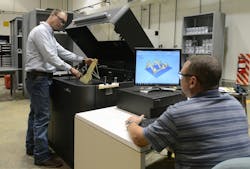Additive manufacturing, popularized in common conversations as “3D printing,” has brought more public attention to the tooling trade than just about any innovation in the last 100 years. Online videos of additive manufacturing have garnered millions of views and show the creation of everything from prosthetic limbs to cars to pancakes.
While the novelty of additive manufacturing has captured the imaginations of non-machinists around the world, some of the most important benefits of the technique have gone largely unnoticed. Additive manufacturing isn’t just novel—it presents an alternative to subtractive manufacturing methods that cuts costs, reduces waste and, most importantly, can improve the safety and function of devices and fixtures.
The Pantex Plant, a federal nuclear weapon facility in Amarillo, Texas, has successfully incorporated additive manufacturing into its tooling operations to revolutionize the way the site pursues its critical mission. In a work environment with little room for error, additive manufacturing has delivered a whole new level of precision and consistency that is helping to ensure the safety of workers, the community and the nation. Furthermore, the plant is seeing undreamed-of cost savings thanks to the reduction in materials and work hours needed to build staple fixtures.
Originally built to provide munitions during World War II, the Pantex Plant has played many roles in supporting American security since 1942. In its first three years of operation, the plant produced nearly 4 million conventional bombs and artillery shells to supply the war effort. Throughout the Cold War era, Pantex assembled thousands of nuclear warheads in an effort to maintain the détente between the West and the Soviet Union. Today, Pantex plays a central role in reducing the U.S. nuclear stockpile while still preserving a small arsenal of weapons as a deterrent to enemy powers.
At first glance, the 74-year-old site may not look like the epicenter of manufacturing innovation. Many of the buildings are starting to show their age and seem to blend in with the surrounding grasslands landscape. Yet inside, engineers and scientists use some of the most sophisticated equipment available today to handle nuclear materials, machine bomb casings and assemble high explosive detonators.
In order to maintain the U.S. nuclear deterrent at a level appropriate for the 21st century, technicians in the Pantex Additive Manufacturing Program have spent the past five years evaluating and implementing dozens of applications for additive manufacturing. The team works with a Connex 500 for polymer-based designs and uses an SML 280 for metals. Components that once took weeks or even months to machine can now be made in mere days. The fruit of the team’s labor is evident across the 16,000-acre facility in the hundreds of fixtures now being used. In 2014, the Additive Manufacturing team received an esteemed Defense Programs Award of Excellence for its work.
Additive Manufacturing for High Explosives Testing
Just one of many additive manufacturing success stories at Pantex involves a recent partnership between the Additive Manufacturing team and the High Explosives Manufacturing department. For years, the High Explosives department relied on a disposable holding fixture to keep high explosives in place during the testing process. Made of glue, acrylic and a special pad that alone cost more than $30, the fixture was expensive, time-consuming to assemble and inadequate for the department’s needs.
The Additive Manufacturing team found a solution by creating a new, one-piece holding fixture through additive manufacturing. The updated fixture is reusable and eliminates the need for pads and glue, thus saving the department more than $300,000 and thousands of work hours every year.
Topology Optimization
The Additive Manufacturing team has ventured into topology optimization in an effort to create stronger tools with less material. Existing designs are evaluated and anything nonessential is eliminated. The process is expected to not only save money, but also to increase safety margins.
An example of a component recently selected for topology optimization is a fixture for the B61-12, America’s most sophisticated nuclear weapon. The B61-12 is currently undergoing a Life Extension Program (LEP) that will replace aging components and assess future weapon performance.
To ensure LEP success, the B61-12 was selected for the Additive Manufacturing for Critical Tooling project to identify possible improvements over the current conventional manufacturing methods and multiple fasteners used to assemble individual fabricated components. By using the topology optimization approach, the Additive Manufacturing team was able to develop a new version of the fixture that exceeds the performance of its predecessor and significantly reduces the associated manufacturing costs, weight and time.
Additive manufacturing is much more than an internet sensation and is making sizable contributions to a number of industries that currently rely heavily on inefficient, expensive subtractive manufacturing. As demonstrated in the last half-decade at the Pantex Plant, this is especially evident within the U.S. nuclear weapons complex. As the tools and materials associated with additive manufacturing improve at this important center of national security, so too will the strength and efficiency of our defense efforts.

